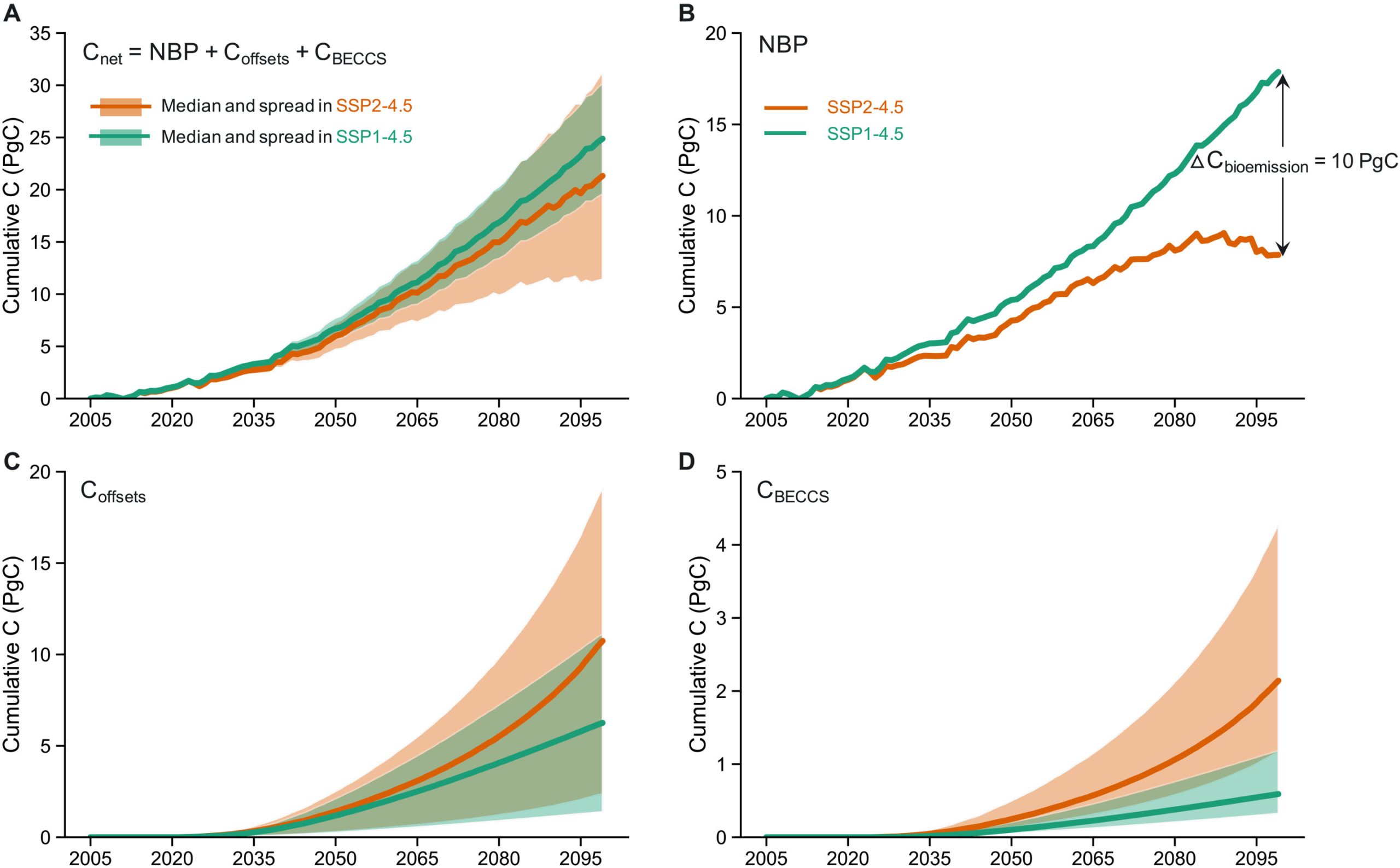
![Net land carbon sequestration and its components for the primarily reforestation-based scenario and the primarily bioenergy-based scenario. Cumulative (A) net land carbon sequestration [sum of (NBP), carbon fossil fuel offsets due to using bioenergy crops (C<sub>offset</sub>s), and carbon captured via BECCS (C<sub>BECCS</sub>); Eq. 5] and its three components: (B) NBP, (C) C<sub>offsets</sub>, and (D) C<sub>BECCS</sub> in SSP2-4.5 (orange color, primary bioenergy expansion scenario) and SSP1-4.5 (green color, primary reforestation scenario) during 2005–2100. The upper bound of the spreads in (C) is when bioenergy is offsetting inefficient fossil fuels (i.e., coal), which is a combination of the lowest fossil fuel offset ratio and the highest carbon content of bioenergy crops (Eq. 3; see Materials and Methods for more details). The low bound is the opposite. The upper bound of the spreads in (D) is with the largest percentage of bioenergy used with CCS and the highest CCS capture efficiency (Eq. 4; see Materials and Methods for more details). Opposite is the low end. The upper/lower bound of the spreads in (A) is the sum of the upper/lower bounds in (C) and (D). The ΔC<sub>bioemission</sub> value (10 PgC) in (B) is carbon emissions due to bioenergy expansion only (Eq. 6). Credit: <i>Science Advances</i> (2022). DOI: 10.1126/sciadv.abm8237 Using bioenergy crops versus reforesting shows crop expansion could lead to water shortages](https://skynews.icu/wp-content/uploads/2022/05/Using-bioenergy-crops-versus-reforesting-shows-crop-expansion-could-lead.jpg)
A team of researchers affiliated with several institutions in the U.S. and Singapore has found that adding bioenergy crops or reforestation would both substantially increase CO2 sequestration, but the former would lead to major water shortages. In their paper published in the journal Science Advances, the group describes their analyses and comparison of the two climate mitigation strategies.
Scientists around the world are searching for carbon removal strategies to address the continued emission of greenhouse gases into the atmosphere. One possible solution is to expand on the use of bioenergy crops; another is to massively replant forests. In this new effort, the researchers looked at both approaches and compared them as possible methods to capturing and sequestering CO2 already in the atmosphere.
The idea behind using bioenergy crops as a capture and sequester technique involves planting CO2-absorbing crops that are reaped and burned as an energy source and capturing and sequestering the CO2 that is released during burning by pumping it underground. Reforestation can be used as a means of sequestering carbon because trees naturally pull CO2 from the air and hold onto to it until they die.
To determine which approach might work better, the researchers used socio-economic models to demonstrate how land might be used under both scenarios from the near future to 2100. The models helped to highlight which places would be best suited to bioenergy crops or reforestation. The team then analyzed the resulting data with an Earth system model that was able to predict environmental consequences due to changes. In their study, the researchers used switchgrass as the bioenergy crop because it requires less water than other crops such as corn. Still, the models showed that planting enough switchgrass to make a major impact on CO2 sequestration would likely lead to massive water shortages because of the amount used to sustain the plants. Reforestation would not present such a problem, of course, since the trees would not have to be watered. But it is still not clear if reforestation would work as intended, either due to warming temperatures that could prevent trees from growing or to an increase in massive forest fires.
Using less-profitable farmland to grow bioenergy crops also supports biodiversity
Yanyan Cheng et al, Future bioenergy expansion could alter carbon sequestration potential and exacerbate water stress in the United States, Science Advances (2022). DOI: 10.1126/sciadv.abm8237
© 2022 Science X Network
Citation:
Using bioenergy crops versus reforesting shows crop expansion could lead to water shortages (2022, May 9)
retrieved 9 May 2022
from https://phys.org/news/2022-05-bioenergy-crops-reforesting-crop-expansion.html
This document is subject to copyright. Apart from any fair dealing for the purpose of private study or research, no
part may be reproduced without the written permission. The content is provided for information purposes only.